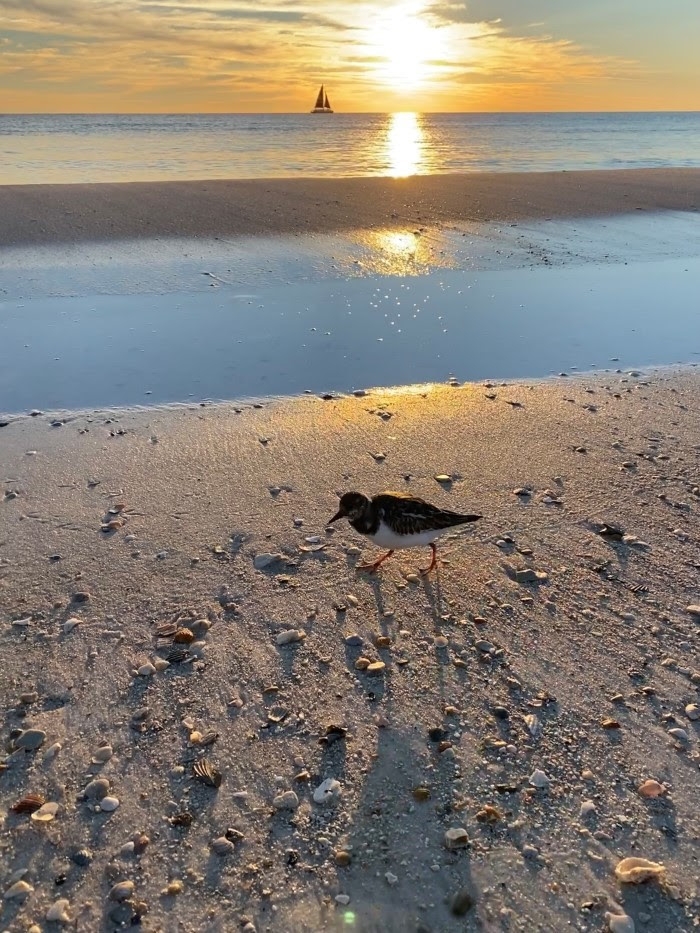How to share Florida beaches with shorebirds during winter
Florida Fish and Wildlife Conservation Commission (FWC)
The Florida Fish and Wildlife Conservation Commission (FWC) is reminding Florida's beachgoers how they can help protect vulnerable shorebirds and seabirds while enjoying coastal habitats during the winter season. Each winter, Florida’s resident shorebirds and seabirds are joined by people and avian snowbirds coming to Florida’s shorelines from colder climates. Resident and migratory shorebirds both rely on Florida’s sandy beaches for important habitat and resting spots. You can have a big impact on conservation of coastal birds, and also help shorebirds and seabirds along coasts, by following these simple shorebird-friendly tips:
• Walk around flocks of birds
Instead of walking straight through, walk around flocks of birds at the beach, and stay out of posted areas. Getting too close to resting shorebirds, seabirds and wading birds can cause them to flush, disturbing birds that may need important rest from long migratory flights.
• Look for Critical Wildlife Area closures.
Be on the lookout for signs designating Critical Wildlife Areas (CWAs) on the beach or coastal islands – these areas are closed to public access to protect high concentrations of wading birds and shorebirds. Boaters and beachgoers can help birds by keeping their distance and noise volumes low near CWAs.
• Keep dogs at home.
Even well-behaved dogs can frighten shorebirds, causing them to panic and expend valuable energy. If you bring your dog with you to the shore, go to a beach where they’re allowed and follow all leash laws.
• Resist the urge to feed the birds.
Sharing snacks with birds at the beach may seem harmless, or even helpful, but it can be harmful to them and other wildlife. Shorebirds and seabirds are healthiest when eating the natural prey they normally forage for, such as small invertebrates in the sand and fish they’ve caught themselves from the water.
• Properly stash all trash and fill in manmade holes with sand.
Trash and food scraps attract predators while litter on beaches and in the water can entangle birds, turtles and other wildlife. Beachgoers can help birds and other native wildlife by properly disposing of all trash, filling in man-made holes in the sand, and removing all personal gear from the beach before sunset. Fishing line can be deadly to waterbirds, sea turtles and other wildlife, so be sure to dispose of it properly. To find a monofilament recycling station near you, visit mrrp.myfwc.com.
For more information about ways to help shorebirds in Florida while at the beach, visit
myfwc.com/conservation/you-conserve/wildlife/shorebirds, or visit the Florida Shorebird Alliance website to learn about shorebird and seabird conservation efforts at FLShorebirdAlliance.org.
Top
The Florida Fish and Wildlife Conservation Commission (FWC) is reminding Florida's beachgoers how they can help protect vulnerable shorebirds and seabirds while enjoying coastal habitats during the winter season. Each winter, Florida’s resident shorebirds and seabirds are joined by people and avian snowbirds coming to Florida’s shorelines from colder climates. Resident and migratory shorebirds both rely on Florida’s sandy beaches for important habitat and resting spots. You can have a big impact on conservation of coastal birds, and also help shorebirds and seabirds along coasts, by following these simple shorebird-friendly tips:
• Walk around flocks of birds
Instead of walking straight through, walk around flocks of birds at the beach, and stay out of posted areas. Getting too close to resting shorebirds, seabirds and wading birds can cause them to flush, disturbing birds that may need important rest from long migratory flights.
• Look for Critical Wildlife Area closures.
Be on the lookout for signs designating Critical Wildlife Areas (CWAs) on the beach or coastal islands – these areas are closed to public access to protect high concentrations of wading birds and shorebirds. Boaters and beachgoers can help birds by keeping their distance and noise volumes low near CWAs.
• Keep dogs at home.
Even well-behaved dogs can frighten shorebirds, causing them to panic and expend valuable energy. If you bring your dog with you to the shore, go to a beach where they’re allowed and follow all leash laws.
• Resist the urge to feed the birds.
Sharing snacks with birds at the beach may seem harmless, or even helpful, but it can be harmful to them and other wildlife. Shorebirds and seabirds are healthiest when eating the natural prey they normally forage for, such as small invertebrates in the sand and fish they’ve caught themselves from the water.
• Properly stash all trash and fill in manmade holes with sand.
Trash and food scraps attract predators while litter on beaches and in the water can entangle birds, turtles and other wildlife. Beachgoers can help birds and other native wildlife by properly disposing of all trash, filling in man-made holes in the sand, and removing all personal gear from the beach before sunset. Fishing line can be deadly to waterbirds, sea turtles and other wildlife, so be sure to dispose of it properly. To find a monofilament recycling station near you, visit mrrp.myfwc.com.
For more information about ways to help shorebirds in Florida while at the beach, visit
myfwc.com/conservation/you-conserve/wildlife/shorebirds, or visit the Florida Shorebird Alliance website to learn about shorebird and seabird conservation efforts at FLShorebirdAlliance.org.
